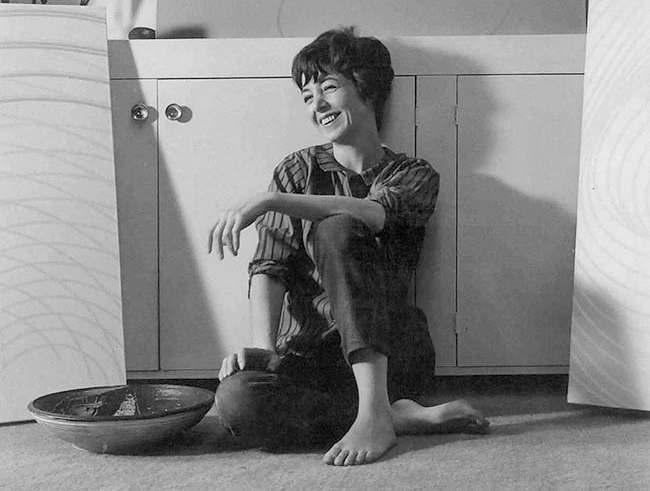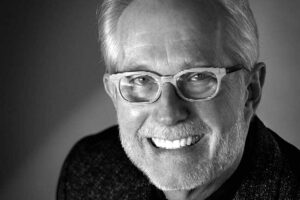June Harwood’s moment: Benton exhibit aims to add her to hard-edge canon

June Harwood in the late 1960s. Photo/by Gerry Kim, courtesy of June Harwood Trust
By Lisa Butterworth | Special to the Courier
June Harwood came to Los Angeles in 1953 with less than two dollars in her pocket, which she used to buy a pack of cigarettes and a cup of coffee upon arrival. But the painter, who died in 2015, left an indelible mark on the Southern California art scene, underscored by the retrospective of her work, “June Harwood: Paintings,” opening August 23 at the Benton Museum of Art at Pomona College.
“It’s just the ideal place for this exhibition because Claremont has such an important history in midcentury art, from furniture design to ceramics, but painting too,” said Dennis Reed, a longtime friend and colleague of Harwood, and trustee of the June Harwood Charitable Trust. “Since June is probably best known as a midcentury hard-edge painter, it just seemed like the perfect fit.”

June Harwood in 1984. Photo/by Doug Rosa, courtesy of June Harwood Trust
Former Benton Senior Curator Rebecca McGrew, who shaped the exhibition of more than 30 paintings spanning Harwood’s five-plus decades of work, agreed. “June Harwood is an amazing painter who is kind of underrecognized,” she said. “The Benton Museum of Art has a fabulous collection of other artists who are hard-edge painters from the same group and the same era. June was an important figure and this is her first survey show, so I just jumped at the chance.” Ephemera including exhibition announcements, telegrams, and Harwood’s own notes will also be on display, providing context for her work.
A master of color and form, Harwood was best known for her hard-edge paintings, a movement that emerged in the late 1950s and ’60s, featuring flat shapes that were sharply juxtaposed, with crisp lines and often vibrant hues. “Some people would look and say they’re abstract, but they’re not abstract in the sense that June or the other hard-edge painters are looking at something and abstracting it,” said Reed. “These are not objective paintings; these are arrangements of shapes and colors.”
The West Coast movement grew in direct opposition to the art scene that had been flourishing in New York at the time, when abstract expressionists such as Jackson Pollock were making big action paintings, full of spontaneous splashes and improvised splatters. By contrast, hard-edge was “this very restrained painting style, where you don’t see brush strokes, just flat shapes of color,” said Reed. “But that doesn’t mean that they’re boring, especially in June’s hands. They have all kinds of energy, and the shapes seem to move around and in and out.”
The process itself, however, could be quite tedious and time-consuming. Harwood would start by creating a small collage for guidance, before marking shapes on the canvas with masking tape to exact the acrylic paint’s “hard edges.”
The phrase hard-edge was coined by the highly regarded critic Jules Langsner, who curated a 1959 show, “Four Abstract Classicists,” featuring Frederick Hammersley, John McLaughlin, Lorser Feitelson, and Claremont’s own Karl Benjamin. In 1964, Langsner curated another show, “California Hard-Edge Painting,” at the Pavillion Gallery in Newport Beach. This time including Harwood — her “breakout show,” said Reed — along with several other women painters, spotlighting their place in a significant movement. “This hard-edge movement in Los Angeles became the first internationally recognized movement in painting done in Southern California, that’s why it’s so crucial,” Reed said. “And many would argue that these simple, flat paintings, almost minimalist in some ways, go on to influence things like the Light and Space movement, which is another later important movement in painting.”
Born in Middletown, New York, in 1933, Harwood couldn’t have known she’d eventually find a place in California’s art culture. But she grew up painting with her mother, whom she adored, and who died when Harwood was just nine years old. Her father, a physician, sent her and her sister to live with relatives until he remarried, to a woman Harwood never liked. Harwood attended Syracuse University, where she earned a B.A. in fine art, and hit the road West the day after graduation, never to return.
“LA was a developing art center at the time, and it’s as far in the continental United States as you can get from where she was,” said Reed. “She came for the sun and the fun and the distance from the life she had had back east, and just wanted to make an entirely new and different life, but in an art community.” She found that community at the Los Angeles Art Association, where she met Feitelson, who became a mentor, and his wife Helen Lundeberg, another painter. A year after her breakout show, she married Langsner, the man who curated it, in Italy. When he died suddenly just two years later, she stopped painting for a bit, possibly the only break she took until her death.

Dennis Reed is a longtime friend and colleague of the late June Harwood, and trustee of the June Harwood Charitable Trust. Photo/by Philip Highley
Reed vividly remembers seeing Harwood’s work for the first time, as a senior in high school who stumbled onto the hard-edge show in Newport Beach after a surf session. But he didn’t meet Harwood until 1980 when, as head of the art department at Los Angeles Valley College, she helped bring him on staff. “June was very intelligent, and she was very sharp verbally — it could be a biting wit if she wanted it to be,” Reed recalled. “She certainly was free-willed; June was not conventional.” Teaching was also an important part of Harwood’s life. After earning her master’s in art from Cal State LA, Harwood first taught at Hollywood High School, then at Valley College from 1975 to 1993.
“I feel I can teach well and understand what kids are groping for,” she told the Los Angeles Times in 1968. “To be a painter, you have to be able to see yourself and understand, and this is difficult for any generation.”
This exhibit will put Harwood’s understanding on display in the most comprehensive way ever shown. “Here in Southern California, I think some of the male members of the hard-edge painters of the mid-century are really well known,” said McGrew. “And I’m really hoping that June’s work will now join that canon.”
“June Harwood: Paintings” is curated by former Benton Senior Curator Rebecca McGrew with curatorial assistant Li Machado and June Harwood Charitable Trust curatorial intern Frances Hayman Sutton, in partnership with the June Harwood Charitable Trust.
More info is at pomona.edu/museum.









0 Comments